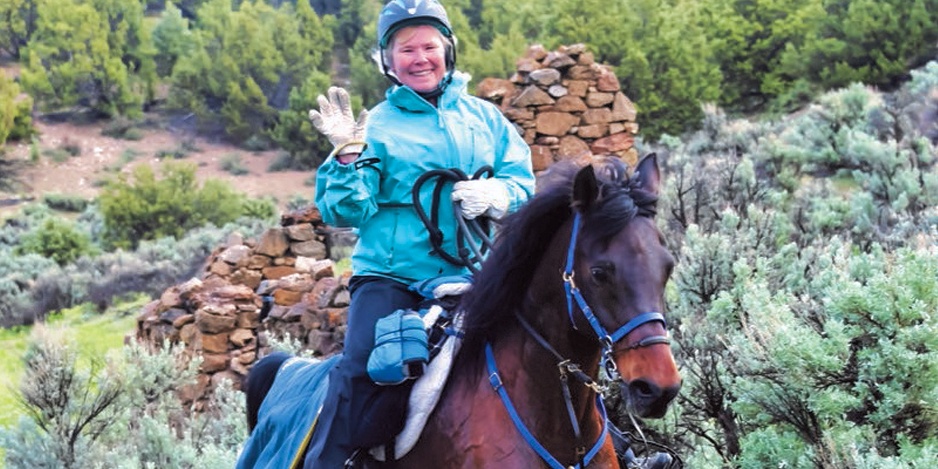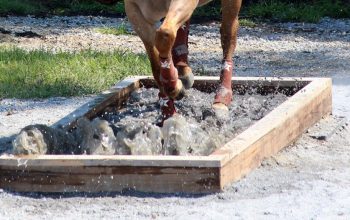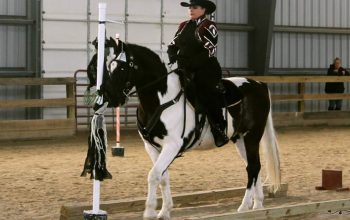By Karen Chaton
In April, 2019, my horse Bo passed the five-year mark since having colic surgery for a 180 degree twist. Bo’s colic began, or became noticed, one morning when I fed him his normal mash and some hay. I checked on him a couple of hours later and, while he had eaten some of his feed, he had not eaten all of it. He was also covered in hives.
I kept a close eye on Bo, and he just didn’t seem right, even though his vitals were all in the normal range. So I loaded him up in the trailer and brought him over to the local vet clinic where the veterinarian examined and tubed and did a rectal, and could not find or feel anything wrong, and vitals were still all in the normal range. So we were sent home. A few hours went by and I still did not think Bo was feeling right, so this time we decided to load up and take him to the next closest vet hospital, which was also a surgical facility. At this point in time we were hoping that putting Bo on fluids would be all that would be needed.

Bo eventually did start to get distended and at some point they let me know that if we were going to do surgery, the sooner the better—as there would be a much greater survival rate. The plan was to go in and do an exploratory and see what was going on and from that point on I could make the decision to continue with the surgery or euthanize on the operating table.
The surgeon came out with good news saying that there was indeed a twist, but it wasn’t completely strangulating anything, so they wouldn’t have to resection anything, and no sign of lesions or other problems. Great! The surgeon told me that he believed Bo would have a 90% chance of survival and of returning to work. They continued with the surgery, which seemed to go fairly fast. Then the surgery team left Bo in the padded surgery room alone for him to wake up.
Fortunately Bo came out of the anesthesia calmly, and as I quietly talked to him through the door he staggered slowly over to me. They let me put a halter on him and walk him into the next building to his recovery stall. Bo was in the vet hospital for about a week before being released. I knew he was ready to go home when I went to visit him one morning and he had managed to reach the nearby halter and lead rope and chewed it all up. That was my Bo! He took it all in stride and was very good-natured but he was clearly ready to get out of his recovery cell . . . errrr . . . stall.
Because Bo had been in such excellent condition going into the surgery, the vet was okay with allowing me to have a little bit of leeway over standard protocols for post-colic recovery rehab. They also started me on a walking rehab schedule immediately which required walking for 15 minutes three times a day.
We walked a mile each time, which worked out to three miles per day or 21 miles the first week. They had me increase the length of time each week and by the second week, when the staples were removed from Bo’s nine-inch incision, they said it would be okay to get on and ride him, plus I got to enlarge his pen. I was also allowed to let him graze as much as he wanted.
Post Surgery
During the first month post-surgery I really wasn’t sure what I was going to do with Bo as far as competing with him in endurance. At first, I was ready to retire him, afraid and fearful that he would have more complications and be more prone to colic. I was lucky to have had a surgeon that at that time had done thousands of colic surgeries, and he told me that Bo had a really high chance of returning to work at least as good as he had been before the surgery, and that horses that survive colic surgery one year will have no greater chance of colic than the normal horse population. Great, I thought, we can wait a year and see how it goes.
Well, Bo clearly had other ideas about taking an early retirement. I did face a lot of negativity when I talked about doing endurance with Bo again, and was told by more than one person that horses are never the same after colic surgery. I was really torn about what to do. Soon, Bo went back to his usual “I’m bored so I’ll dismantle the barn and anything else within reach” mode. He started moving stall mats around, moving 75-gallon water troughs out into the yard, and taking down the rain gutters on the barn. At this point we were already up to about 35 miles a week of walking with some trotting so they told me to up it some more and just a few weeks post-surgery we were up to 42 miles a week.
Back After Surgery
I decided to listen to Bo and his surgeon and not the naysayers, and entered Bo on one day of the Wild West ride in California as our first ride back after surgery. I chose that ride because of the competent and very experienced vet staff, and also because it was within reasonable distance to my vet clinic, the vet checks that day were in camp and Bo and I knew the trail well. We rode carefully and I was . . . I guess you could say hyper-alert to every minor detail, every horse snort, sigh and fart, and I’d hold my breath while doing a 10-point inspection to make sure nothing felt off or wrong. Bo quickly put me at ease, well, at least as well as could be expected under the circumstances. We completed the ride in terrific shape, tears were flowing and I was super choked up as we approached the finish line. I think that this was and always will be one of the best rides I’ve ever had. At that point in time, Bo only needed a handful of rides to reach 8,000 miles.
Fast forward five years later and we not only passed the 8,000 mile mark but, at Tevis in 2018, Bo went over 10,000 miles.
He had completed the Tevis three times before having surgery, and has since completed it three more times for a total of six. Every time Bo does Tevis, he makes it easier for us both. He now also has 10 one-day 100 mile completions and an overall 98% completion rate. I really feel that Bo not only came back to his previous level of athletic ability, but has continued to improve and do even better.
I have been enjoying sharing Bo with juniors that he takes very good care of at endurance rides, poker rides, parades and other events. This is Bo’s 13th ride season. I know I was fortunate that things turned out the way that they did. Facing something as real and serious as a colic surgery is horrifying, and incredibly mentally (and financially) draining. It’s difficult for the horse, and the horse’s owner and family.
Was it worth it?
In my case I believe that it was because of the emotional attachment that I have with Bo. I’m glad that I made the leap knowing that, if it had not of worked out, at least I tried to give Bo every chance I could. I was also fortunate enough financially to be able to do this. My heart breaks for those who end up in this situation and have to make a different decision. I have had to make other financial sacrifices in order to pay for Bo’s vet care which includes not attending as many endurance rides, or even getting another horse (Bo is 22 years old now), so every ride we do get to is to be cherished. Go ride while you can, it will never be easy.





